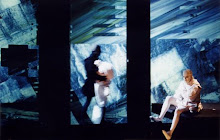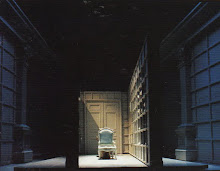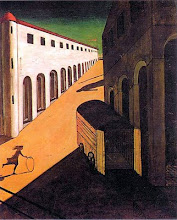Wednesday, 25 August 2010
Saturday, 21 August 2010
Friday, 6 August 2010
Friday, 23 July 2010
Tuesday, 20 July 2010
Tuesday, 1 June 2010
Creating virtual sets
It was considered to build the sets as physical models, film them and then edit the footage and add layers in After Effects, using camera tracking; this technique was already used in the development of the film in Part II but it proved to be problematic, in particular when trying to control the camera movement through the physical set. In order to allow more control over the sets and facilitate manoeuvre (i.e. camera movement), they will be build using two-dimensional components to create a 2.5 dimensional space in After Effects, therefore a virtual environment.
This video is a very basic test to try effects of light and duplicated layers in After Effects.
This video is a very basic test to try effects of light and duplicated layers in After Effects.
Developing the narrative of the film project
The departure of the story now is that of a subject creating his own reality as a means of escape from the collective reality of the contemporary city (this concept appears also in Part I). Following this idea, the structure of the narrative is divided in two parts, which are articulated through the element of the ‘temple’ (container of spatial system), differentiating between an outside and inside, between one reality and another. The first part is a collective urban reality (outside the ‘temple’) as an introduction representing the context-site interpretation; the second part is a synthetic reality projected by the subject (inside the ‘temple’) as a representation of mental space and time. The development of the narrative within the synthetic reality follows the analysis and mapping out of ‘Last year in Marienbad’, throughout the five sets (corridor, hall, room, gallery and garden).


Monday, 10 May 2010
Project 004_presenting the work


These sketches show how the main body of work would be presented. It consists of two parts: the model-container (which represents a place; fragments are visible only through peepholes; the sequence of static shots gives the idea of motion of the place contained in the film) and the film (which represents concrete space, creating a spatial sequence system; the place represented in the model-container is used as a ‘raw’ material).
Project 004_notes
Provisional title:
On representation
On interpretation
‘The foregoing story implies this: architecture, as distinct from building, is an interpretive, critical act. It has a linguistic condition different from the practical one of building. A building is interpreted when its rhetorical mechanism and principles are revealed. This analysis may be performed in a number of different ways, according to the forms of different types of discourse; among these are theory, criticism, history and manifesto. An act of interpretation is also present in the different modes of representational discourse: drawing, writing, model making and so on. Interpretation is also integral to the act of projecting.’ (Beatriz Colomina, 1988, Architectureproduction, p6)
Process:
Text/context (basis) > Interpretation (analysis and mapping out) > Representation (various media)
Text/context starting point:
- Narrative, storytelling text: from ‘Last year in Marienbad’
- Cultural, geographical, socio-political context (in relation to the text of ‘Last year in Marienbad’; concepts from the text are translated to concepts that refer to the context described; i.e. Ambiguity, uncertainty, repetition, time-space continuum, sense of no-place): from western society, late-capitalism (new economies impact on urban events), contemporary city (London) > Introduction of a reflection on the contemporary metropolis in relation to the subject. > Chosen site (TBC): east London, suburbia, areas with sense of no-place, homeless character. > Document
On representation
On interpretation
‘The foregoing story implies this: architecture, as distinct from building, is an interpretive, critical act. It has a linguistic condition different from the practical one of building. A building is interpreted when its rhetorical mechanism and principles are revealed. This analysis may be performed in a number of different ways, according to the forms of different types of discourse; among these are theory, criticism, history and manifesto. An act of interpretation is also present in the different modes of representational discourse: drawing, writing, model making and so on. Interpretation is also integral to the act of projecting.’ (Beatriz Colomina, 1988, Architectureproduction, p6)
Process:
Text/context (basis) > Interpretation (analysis and mapping out) > Representation (various media)
Text/context starting point:
- Narrative, storytelling text: from ‘Last year in Marienbad’
- Cultural, geographical, socio-political context (in relation to the text of ‘Last year in Marienbad’; concepts from the text are translated to concepts that refer to the context described; i.e. Ambiguity, uncertainty, repetition, time-space continuum, sense of no-place): from western society, late-capitalism (new economies impact on urban events), contemporary city (London) > Introduction of a reflection on the contemporary metropolis in relation to the subject. > Chosen site (TBC): east London, suburbia, areas with sense of no-place, homeless character. > Document
Subscribe to:
Comments (Atom)





















